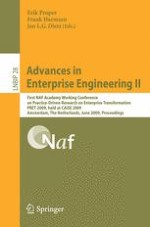the virtually unlimited possibilities of modern information and communication technology. Future enterprises will therefore have to operate in an ever more dynamic and global environment. They need to be more agile, more adaptive, and more transparent. In addition, they will be held more publicly accountable for every e?ect they produce. These challenges are traditionally addressed by black-box thinking-based knowledge, i.e., knowledge concerning the function and the behavior of ent- prises, as contained in the organizational sciences. Such knowledge is su?cient, and perfectly adequate, for managing an enterprise (within the range of c- trol). However, it is de?nitely inadequate for changing an enterprise. In order to bring about changes, white-box-based knowledge is needed, i.e., knowledge concerning the construction and the operation of enterprises. Developing and applying such knowledge requires no less than a paradigm shift in our thi- ing about enterprises, since the organizational sciences are dominantly oriented toward organizational behavior, based on black-box thinking.
